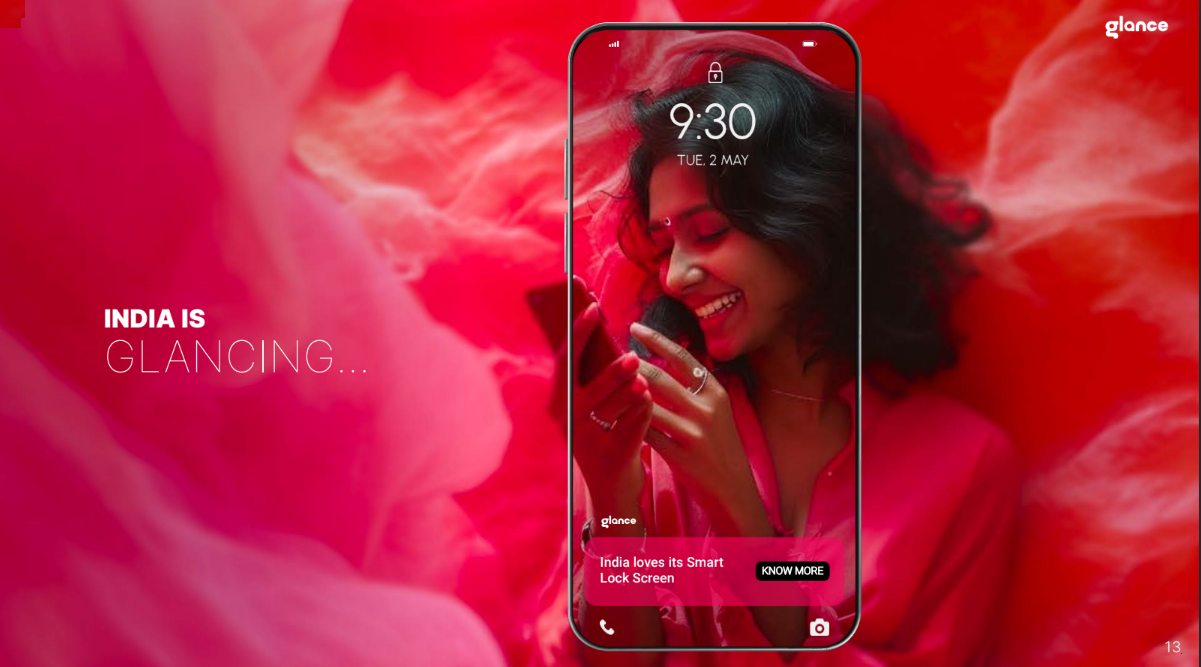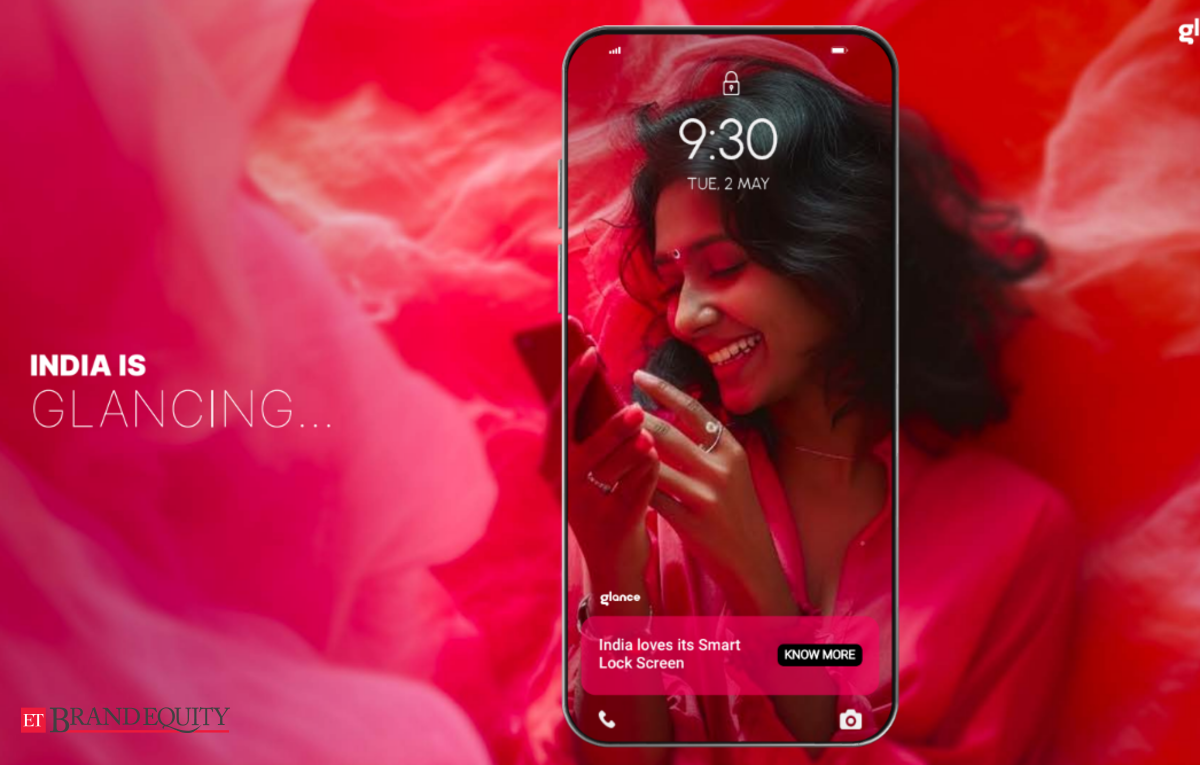[ad_1]

One Glance to rule them all,One Glance to find them,
One Glance to bring them all,
And in the Smartphone bind them.
Think about the number of times you glance at your smartphone in a day. The average number of glances per person per day is ~150. Now, multiply this number with lockscreen experience provider Glance’s 235 million active users in India and that’s the reach of the technology platform daily. The potential is much larger.
Glance plans to expand its presence on 1 billion devices by 2025 globally. It is currently present on ~450 million devices worldwide. The platform has revenue sharing agreements with most of the leading OEMs in India such as Mi, Realme, Samsung, Oppo, Vivo, Transsion, and Gionee. 80% of new Android devices sold in India are natively integrated with the Glance platform. OnePlus, Google Pixel and Nothing are some of the notable Android OEMs who have not partnered with the platform.

The user journey for the platform doesn’t end there because smartphone users still have to opt-in to enable the lock screen experience. Bikash Chowdhury, chief marketing officer, Glance stated, “When we started five years ago there was no vocabulary on what is the lock screen experience. Different people described it as the power screen, on-screen or home screen. So, in the last five years, we’ve created a whole vocabulary around it.”
He further explained, “One of the imperatives for Glance is to educate the user on what the platform can do for them because when a user starts to see content on their lock screen they have to decide whether it is spam or it creates value.”
The amount of education that is required can vary depending on the geography. Chowdhury remarked that since the user profile in India is younger (47% of Glance’s users are <24 years old) there’s less need for education because the target audience is tech-savvy. However, in markets like Japan the average age of the demographic is on the higher side. Hence the education that the brand needs to do is much higher.
Growth
Unlike apps whose scale is determined by number of downloads, the growth of Glance depends on different levers. The first lever of growth is how many geographies the platform is present in. It is crucial that there is a strong presence of Android devices in the geography as Glance is not available on iOS devices. Currently, these regions are India, Southeast Asia, Japan, and North America.
The second lever of growth is how many Android OEMs and telcos the platform works with in those regions. This is significant because in countries like China, OEM providers and telcos are already working in tandem to provide lockscreen experiences making it harder for challengers like Glance to penetrate into the market.
The third lever of growth is how many markets the OEM provider is present in. In India, Samsung is leading the market share in the smartphone segment with 17.2% share, as per Counterpoint Research data (Q3 2023) however in the ultra premium segment (>1000$) it is second to Apple which dominates with 71% share (Counterpoint Research, 2023). Similarly, in the affordable premium segment, OnePlus is the leading smartphone brand with 29% share (Counterpoint Research, Q3 2023).
A majority of Glance user’s belong to the $150-250 price segment (Counterpoint Research) owing to the popularity of this price segment in India’s smartphone market. So, it’s vital that Glance expand not just its number of partners but also the number of markets it is present in.
Discovery
Glance partners with publishers, OTT platforms to curate a live feed of relevant content for users to consume. It avoids user-generated content to keep the lock-screen experience premium and to potentially avoid regulatory oversight. Out of 1500 employees of the company, its editorial team comprises a staff of 200 that control what appears on the lock screen. News (19%), sports (18%), entertainment (16%), gaming (13%) are some of its biggest genres of consumption.
The platform is emerging as a key channel for the media and publishers to get their content discovered by users. Last year Glance created a live score widget for users to keep track of scores of IPL and ICC Men’s World Cup matches. The widget attracted 3.5 million daily active users and 23 billion glances for stories around the World Cup.
200K Glance users watched the Chandrayaan-3 landing live on their smart lock screens. Similarly, in entertainment the film release of Jawan saw users glance at the news 4.7 billion times and tap 41 million times.
OTT platforms like JioCinema have partnered with Glance for its hit reality show Bigg Boss attracting over 6 billion+ glances and 49 million+ user attempts to engage in a contest that gave them a chance to meet Salman Khan.
For most apps, the monthly retention rate is less than 10%. This means that if 100 users downloaded your app on day 1, more than 90 would have uninstalled the app by day 30. This presents quite a dilemma for brands and publishers who want to tap into user’s day to day consumption.
Further, with anywhere between 80-100 apps present on a user’s smartphone, getting a share of the user’s attention is becoming increasingly difficult for brands. Even direct engagement channels such as Email SMS, WhatsApp are quickly becoming cluttered with notification and promotional messages.
If Glance gets the user experience right, it would own the surface of the lock screen and deliver value for brands and publishers who want to reach consumers. Personalisation is key to build user trust on the platform and once that is instilled in the platform, brands that operate in partnership with Glance would find more resonance with consumers.
In 2023, Glance worked with 300-320 out of the top 500 advertisers who wanted to reach consumers across the marketing funnel. The platform saw 12-15% growth in ad spend year-on-year. Nearly every consumer category including FMCG, OTT, auto & durables, e-commerce & retail, BFSI, home, tech, health and digital-first brands have associated with the platform to drive their marketing objectives, according to Vasuta Agarwal, chief business officer, InMobi Group. She said, “Digital-first brands particularly e-commerce, OTT, food delivery and fintech are seeing a high traction on the platform.”
Agarwal explained, “Whenever there’s any occasion-based consumption like audiences watching a cricket event at home, that’s when the digital-first brands want to get into front of the consumer, especially to capture that spike in demand. The advertiser sentiment is that Glance is a powerful platform to get in front of the consumer for things that are time-bound.”
In 2023, the platform saw a big shift in major advertisers with crypto and gaming category spends going down whereas FMCG brands showcased a lot more interest, especially when it came to engaging with their target audience.
Depending on the brand objectives Glance offers a cost-per-mile (CPM) based pricing model that might change to cost per install as per the client KPIs, or cost per completed view in the case of video inventory. In cases where brands want to generate a high-impact, high reach campaign such as in the case of a new product launch, announcing a sales season then they can explore a sponsorship model where they can reach the entire Glance user base and gain a high share of voice in a single day.
The platform is also being leveraged by publishers and mobile app developers, especially game developers, to drive user discovery, growth, and re-engagement.
Surfaces Economy
Rather than a social media platform, Glance has positioned itself as a curated content platform that is bringing its coverage to all kinds of surfaces. Currently, it is present on the lock screen but in mature markets like the US its coverage extends to the home screen.
While Glance has made significant headway on smartphone devices, it is targeting all intelligent surfaces that consumers interact with daily. The Glance team has a product ready for Smart TVs that allow it to bring the Glance experience to the ambient screen of TV sets.
Chowdhury explained, “The personalisation of the ambient screen of a TV is not at the same level of a smartphone but it is a manifestation of what you see on the phone. Since TV is a visual product and the screen is much bigger there’s a lot of room for play. So, things like sports scores and entertainment trailers take on a whole new dimension.”
Much like the smartphone, the smart TV ecosystem is supported by a lot of players such as the OEMs, direct-to-home service providers, cable operators and broadband providers. As per E&Y figures, 90% of television sets sold in 2023 were Smart TV with 35 million connected TVs (CTVs) at the end of the year. In a few years, television consumption may shift predominantly to CTV.
While users associate smartphones with apps, the idea of an app-less ecosystem is quite novel. Chowdhury remarked that unlike most brands that follow the AIDA model (awareness, interest, desire, and action), most users may find themselves already using Glance without even knowing it. Also, unlike an app, Glance cannot be uninstalled, only disabled in the settings, therefore the real challenge is to create mental availability among users. According to Chowdhury, education is the only way to make that happen.
A recent BCG report titled ‘Reimagining the Smartphone Experience’ explored the role of surfaces as an additional layer of interaction between users and apps. Even within a smartphone, a user journey can take up to eight taps before they reach the desired goal. Intelligent AI-powered surfaces can save the number of taps it takes a user to complete their journey and also reduces the resulting decision fatigue.
Nobody wakes up in the morning thinking about their favourite brand. However, the BCG study highlights that 84% of users check their phones within 15 minutes of waking up and half of these users may engage in this behaviour subconsciously. Right now, a lockscreen surface is just a place where you check the date, time and missed phone calls/messages, however, with players like Glance elevating the surface experience may forever change the way how users engage with their smart devices.
[ad_2]
Source link








